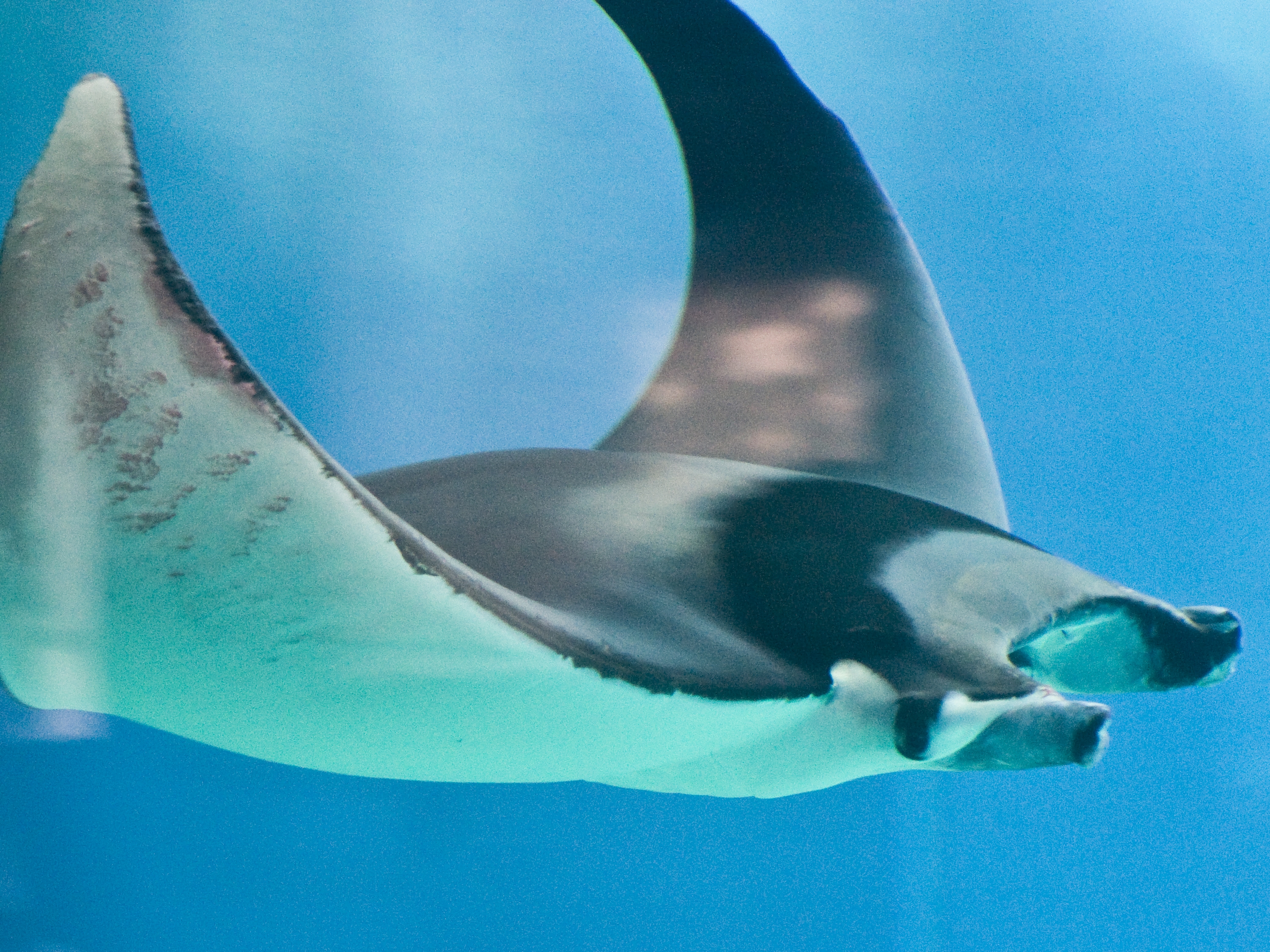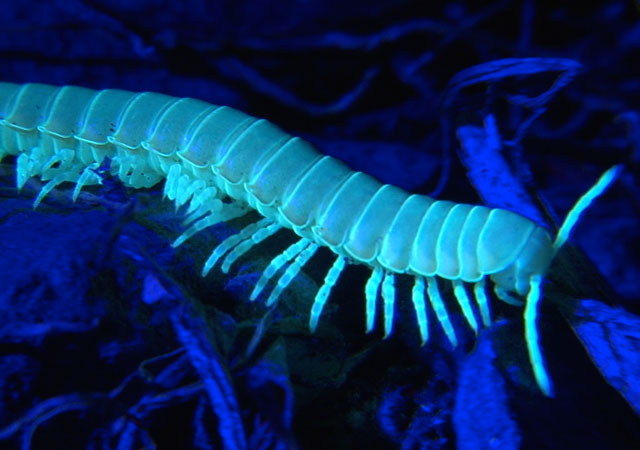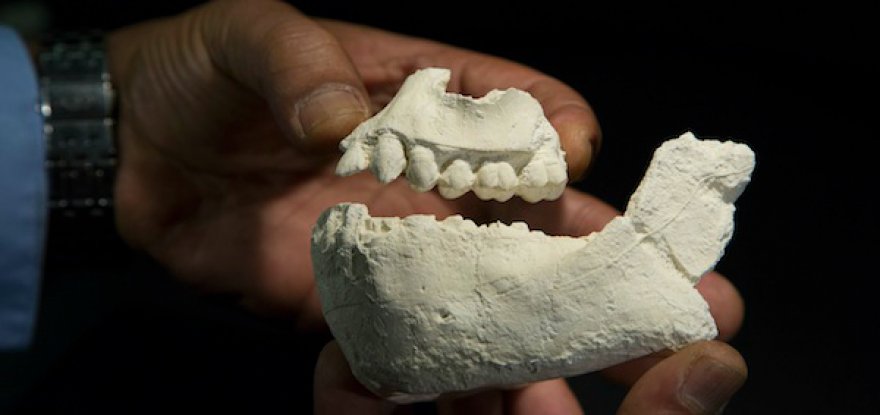Not seen for nearly 50 years, the small, blind millipede Xystocheir bistipita, was recently rediscovered in the foothills of San Luis Obispo, California by entomologist Dr Paul Merek of the Virginia Polytechnic Institute.
Analysis of Xystocheir bistipita's DNA revealed that the millipede actually belonged to a different genus, Motyxia - the only genus of bioluminescent millipede in the western hemisphere.
The identity-challenged millipede was then renamed Motyxia bistipita.
The researchers ranked the light intensity and toxicity of all the millipedes in its newly acquired family and found that M. bistipita is pretty dull and less toxic compared to its mountain-dwelling cousins, which are larger and much more luminous.
The brighter the millipedes were, the more cyanide they contained, which suggests the millipedes at higher elevations use bioluminescence as a forewarning to predators.
M. bistipita has very few predators - so why does it still glow in the dark? Unlike fireflies that glow because of an enzymatic reaction that converts a pigment called luciferin into a new compound that emits light, bioluminescence in millipedes is caused by the reaction of a photoprotein that uses magnesium and molecules that contain oxygen.
"After we sequenced them we were able to place the millipede on an evolutionary tree with other bioluminescent species of Motyxia," says Marek.
source: go here
Thursday, 28 May 2015
Newest Member of the Homo Family: Australopithecus deyiremeda
They combine both Human and apelike features...
This no doubt in the world of evolution suggests that they were an early ancestor of Homo sapiens ie the human generation which has existed for only but 200, 000 years approximately.
Researchers have confirmed that a new hominin ancestor lived in Ethiopia between 3.3 and 3.5 million years ago, at the same time as the 'Lucy' species, Australopithecus afarensis.
"The new species is yet another confirmation that Lucy's species, Australopithecus afarensis, was not the only potential human ancestor species that roamed in what is now the Afar region of Ethiopia during the middle Pliocene," lead author, Yohannes Haile-Selassie, from the Cleveland Museum of Natural History in the US, said in a press release.
 "Current fossil evidence from the Woranso-Mille study area clearly shows that there were at least two, if not three, early human species living at the same time and in close geographic proximity." The new species was identified from a series of teeth and jaw bones that were discovered in 2011 in the central Afar region of Ethiopia, just 35 kilometres from the remains of 'Lucy', one of the most complete hominin skeletons ever discovered.
"Current fossil evidence from the Woranso-Mille study area clearly shows that there were at least two, if not three, early human species living at the same time and in close geographic proximity." The new species was identified from a series of teeth and jaw bones that were discovered in 2011 in the central Afar region of Ethiopia, just 35 kilometres from the remains of 'Lucy', one of the most complete hominin skeletons ever discovered.
The lower jaws were also far more robust then jawline of A. afarensis, leading the researchers to classify the remains as a new species, which they've called Australopithecus deyiremada - deyiremada is taken from words that mean "Close relative" in the language of the Afar people.
The team then looked at the sediment on the remains, and used radiometric dating and palaeomagnetic data to work out when the new species lived.
150527134040 1 900x600Yohannes Haile-Selassie/Cleveland Museum of Natural History "This new species from Ethiopia takes the ongoing debate on early hominin diversity to another level," said Haile-Selassie.
"Some of our colleagues are going to be skeptical about this new species, which is not unusual. However, I think it is time that we look into the earlier phases of our evolution with an open mind and carefully examine the currently available fossil evidence rather than immediately dismissing the fossils that do not fit our long-held hypotheses." The challenge now is convincing the skeptics that A. deyiremada is indeed a separate species to Lucy - something that's pretty difficult given that we don't know much about how our ancestors looked or behaved.
sources: source 1, source 2
This no doubt in the world of evolution suggests that they were an early ancestor of Homo sapiens ie the human generation which has existed for only but 200, 000 years approximately.
Researchers have confirmed that a new hominin ancestor lived in Ethiopia between 3.3 and 3.5 million years ago, at the same time as the 'Lucy' species, Australopithecus afarensis.
"The new species is yet another confirmation that Lucy's species, Australopithecus afarensis, was not the only potential human ancestor species that roamed in what is now the Afar region of Ethiopia during the middle Pliocene," lead author, Yohannes Haile-Selassie, from the Cleveland Museum of Natural History in the US, said in a press release.
 "Current fossil evidence from the Woranso-Mille study area clearly shows that there were at least two, if not three, early human species living at the same time and in close geographic proximity." The new species was identified from a series of teeth and jaw bones that were discovered in 2011 in the central Afar region of Ethiopia, just 35 kilometres from the remains of 'Lucy', one of the most complete hominin skeletons ever discovered.
"Current fossil evidence from the Woranso-Mille study area clearly shows that there were at least two, if not three, early human species living at the same time and in close geographic proximity." The new species was identified from a series of teeth and jaw bones that were discovered in 2011 in the central Afar region of Ethiopia, just 35 kilometres from the remains of 'Lucy', one of the most complete hominin skeletons ever discovered.The lower jaws were also far more robust then jawline of A. afarensis, leading the researchers to classify the remains as a new species, which they've called Australopithecus deyiremada - deyiremada is taken from words that mean "Close relative" in the language of the Afar people.
The team then looked at the sediment on the remains, and used radiometric dating and palaeomagnetic data to work out when the new species lived.
150527134040 1 900x600Yohannes Haile-Selassie/Cleveland Museum of Natural History "This new species from Ethiopia takes the ongoing debate on early hominin diversity to another level," said Haile-Selassie.
"Some of our colleagues are going to be skeptical about this new species, which is not unusual. However, I think it is time that we look into the earlier phases of our evolution with an open mind and carefully examine the currently available fossil evidence rather than immediately dismissing the fossils that do not fit our long-held hypotheses." The challenge now is convincing the skeptics that A. deyiremada is indeed a separate species to Lucy - something that's pretty difficult given that we don't know much about how our ancestors looked or behaved.
sources: source 1, source 2
A Fish that Flies (Mobula Ray's)
 Mobula
is a genus of ray in the family Myliobatidae. Their appearance is
similar to that of manta rays, which are in the same family.
Mobula
is a genus of ray in the family Myliobatidae. Their appearance is
similar to that of manta rays, which are in the same family.
source: Wikipedia
These marine animals, which are often referred to as devil rays because their heads have two horn-like points, can soar through the air for up to a few seconds at a time before belly-flopping back to their watery home.
Scientists propose that it could be a mating ritual, a way to feed, or just a fun activity, but no one is certain, yet.
Octavio Aburto, an assistant professor at the Scripps Institution of Oceanography, came upon a giant swarm of thousands of these flying devil fish near the Gulf of California in 2011.
Most of the mind-blowing photos you'll see here were taken during that encounter by Aburto with the International League of Conservation Photographers.
Source: go here
Saturday, 16 May 2015
Sitting Does Damage Your Body
Watch Video Here
If you're anything like us, you've spent at least 80 percent of your day sitting down so far.
Sitting on a bus on the way to work, sitting at your desk, sitting at lunch... well, you get the idea.
Unless you've been living without the Internet for the past five years, you'll be well aware by now how bad that it is for you.
Created by animator Duncan Elms for Australian news program 60 Minutes, this is one of the best summaries of the research we've seen so far, and also helps to explain why something so seemingly innocent can potentially trigger such broad problems, such as cardiovascular disease and diabetes.
Along with the usual suspects of weight gain and back pain, the animation explains how, as soon as you sit down, the enzymes that break down fat drop by 90 percent, and your insulin effectiveness and good cholesterol levels drops.
Sitting also makes blood clots more likely to form in your brain, and people with desk jobs are twice as likely to suffer from heart disease than those with active jobs.
Source
Saturday, 2 May 2015
The waters of Lake Michigan are so crystal clear that you can see all of its secrets laid bare from the sky.
Despite how inviting the perfect blue water looks, don't be deceived, it's still only around 3 degrees Celsius.
One of the coast guard pilots, Charlie Wilson, told NPR that it's "Fairly common" to see a wreck from the sky, but "Not in the numbers we saw on that flight".
They've since shared their images on the US Coast Guard Air Station Traverse City Facebook page, calling the event "Shipwreck Sunday".
Some of the wrecks they spotted were well known, including the remains of the James McBride, photographed below, which sank in shallow water during a storm on 19 October 1857.
Lake-michigan-shipwrecks vert-172f028979b49270e3d2c5332e26dde2bcbd307d-s700-c85US Coast Guard Air Station Traverse City 11159957 451769294989741 2938430622155184893 nUS Coast Guard Air Station Traverse City Also in shallow water was the well known wreck of the Rising Sun, photographed in the top image, which went down in 1917 - thankfully all 32 people on board at the time were rescued.
These wrecks were all photographed near Sleeping Bear Point northeast along the shoreline to Leland, the US Coast Guard reports.
read more here1
continue reading here 2
Saturday, 25 April 2015
Chile's Volcanic Eruption Created Lightening
Earlier this week, Chile's Cabulco volcano started erupting for the first time in 43 years, spraying dust and ash at least 15 kilometres into the sky, and causing the evacuation of up to 2,000 local residents.
Thankfully there have been no casualties or serious injuries reported, but the volcano has put on one hell of a show, producing a breathtaking display of volcanic lightning with its second eruption and blasting out red-hot rocks and lava.
You can marvel at the power of nature in the incredible time-lapse footage below.
What causes volcanic lightning? As Bec Crew wrote for ScienceAlert last month, this eerily beautiful phenomenon is triggered when giant ash clouds spew out of a volcano's mouth: "As the individual ash particles make contact and rub against each other, they produce enough static electricity to convert into bursts of lightning." This ash cloud has since caused flight cancellations as it blows across South America, and has produced a plume that can be seen from space.
The below infrared image was taken by the Suomi NPP satellite on 23 April.
1696v1 20150423-Calbuco web NASA's Terra satellite also snapped a natural-colour photo of the ash plume, below: calbuco tmo 2015113NASA And there have been no shortage of amazing Earth-bound images across Twitter.
Calbuco Volcano erupts in nearby chile! Hopefully no serious casualties.
Read more here.
Sunday, 19 April 2015
A Second Brain in Guts
Okay, so your second brain isn't really a brain at all.
It's more of a 'brain' that happens to live in our stomach and helps regulate an amazing number of feelings and emotions.
Known as the enteric nervous system, this is the mechanism behind all those "I'm going with my gut on this", "I'm having a gut reaction", and "I had a gut-wrenching experience" phrases that have become so much a part of our everyday parlance.
You probably already know that we have a whole lot of neurons - nerve cells that form the basis of our central and peripheral nervous systems - in our spine, but did you know that we have the same number lining the long tube of our gut? The complex make-up of our gut means it's able to create intense cravings - why do I suddenly need a cheeseburger immediately? - without even communicating with our actual brain, says Vanessa Hill in the latest episode of BrainCraft.
It's not just the neurons packed into our stomach that pretty much tell us what to do, says Vanessa - the buzzing microcosm inside is also busy exerting its influence.
Called the microbiome, this colony of bacteria is determined by many factors, such as how old you are, where you live, what you eat, and even how stressed-out you are, and it can communicate with our central nervous system to control everything from how anxious you are about a particular task, to how likely you are to approach things with Kimmy Schmidt levels of positivity.
We're only just now figuring out the extent of its influence over us.
Read more
Subscribe to:
Comments (Atom)







